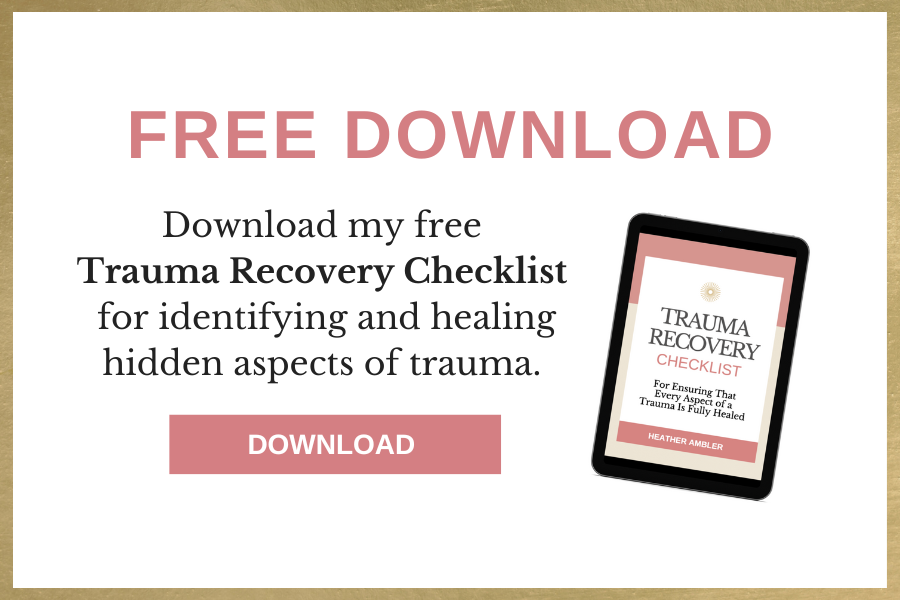5 Ways to Tell That a Trauma Is Completely Healed
- heather7021
- Feb 10, 2024
- 4 min read

What does it mean to heal trauma? What does it mean for a trauma to be completely healed?
For the purposes of this article, I’ll be using the following two definitions. The first we can think of as “big T” trauma, and the second we can think of as “little t” trauma.
1. A disordered psychic or behavioral state resulting from severe mental or emotional stress or physical injury
2. An emotional upset

Now let’s talk about the signs of a trauma which has been healed. What are the key markers?
1) When you think about the traumatic event, it's not upsetting and it doesn’t hurt anymore.
And if you can’t remember the traumatic event itself (because you were too little when it happened, or you were unconscious, or the memory is repressed), when you think about the fact that it happened, it does not hurt anymore.
You have no painful feelings in relation to the event. At all. Period.
This means that you don’t feel sadness, anger, resentment, fear, shame, regret, anguish, or any other painful or distressing emotion.
2) If you had symptoms of PTSD, they are no longer present.
This may include symptoms like:
Flashbacks
Nightmares
Intrusive thoughts
Emotional outbursts
Difficulty concentrating
3) You no longer have any fears related to the traumatic event or memory.
For example, if you were in a car accident on the freeway, and ever since then, you’ve been afraid of driving on the freeway, when that traumatic memory is fully healed, you would no longer have a fear of driving on the freeway.
This means that the memory of the accident itself, as well as memories of anything that happened to you as result of the accident, are no longer upsetting to you, such as:
Police and/or paramedic interactions
Injuries suffered by you or anyone else involved in the accident
An ambulance
The hospital
Medical appointments
Dealing with insurance
Court cases
How the accident affected your family, etc.
This is true for any kind of trauma, whether it’s abuse you suffered as a child, losing your job when you were in your 20s, or getting divorced in your 40s.
When it is completely healed, you think about what happened, you will not experience any:
Sadness
Anger
Resentment
Fear
Shame
Embarrassment
Guilt
Regret
Anguish
4) You no longer have any trauma responses to the event.
What is a trauma response? In the simplest terms, it is a response to trauma. In this context, it’s a present moment response to a trauma you experienced at some point in the past—yesterday, last year, or 40 years ago.
Trauma responses take many forms. Usually, at one point in time, they’re adaptive, but eventually they become maladaptive, and can prevent you from being happy, healthy, and fulfilled.
Examples include:
The fight, flight, freeze response (some people add “fawn” to this, but for now, let’s just focus on the fight, flight, and freeze). This is basic nervous system stuff, where you go into sympathetic mode of survival in response to a perceived threat. This is often unconscious. The response is unconscious, and the perception of threat is unconscious.
Using substances like alcohol, drugs, cigarettes or food to self-soothe. When we’re hurting, we need to be soothed. When trauma is healed, it doesn’t hurt anymore, and the need for soothing drops away.
Carrying extra weight as a (usually unconsious) way to protect yourself from sexual attention. This is a very common trauma response to sexual abuse.
Engaging in co-dependent behaviors as a way to get your own emotional needs met.
This is a tiny snippet of a very long list. The point here is that as trauma heals, maladaptive responses to trauma drop away.
It’s important to note that these responses were developed to protect you. Though they eventually ended up hurting you, they came from a part of you that loved you and wanted to keep you safe. And that’s a very good thing!
5) You will no longer have any false, painful, or limiting beliefs related to the traumatic event.
This could include beliefs like:
What happened to me is my fault.
I'll never recover from this trauma.
I'll always be in pain about this trauma.
I should have been able to prevent this.
When Complete Healing Seems Impossible
If you haven’t experienced this kind of total healing before, I know that it can seem like a tall order.
It can even seem impossible. But I assure you, it is possible.
No trauma is too big, too painful, or too devastating for the healing power of EFT
So if you have a traumatic event in your life which is causing you to suffer, know this: You can heal.
You can be completely free from any negative effects of this event. No pain. No fear. No resentment. No trauma responses, limiting beliefs, or maladaptive behaviors or patterns which you may have developed as a result of this trauma.
If you’ve already tried to heal one or more traumas with EFT (or another healing modality, like EMDR, psychotherapy, etc.), and you weren’t able to heal it completely in the ways that I’ve described here, I recommend working with a professional EFT practitioner.
If you decide that this is the best course of action for you, and you’d like to work with me, click here to schedule an EFT session or free consultation.
You may not believe that you can completely heal whatever it is that’s causing you to suffer.
That’s okay. You don’t need to believe it. EFT tapping will heal it anyway.
You can heal. You deserve to heal. And if you give EFT a chance, you will heal.

BY HEATHER AMBLER
Heather Ambler is an EFT practitioner and mindset coach in California. Through her private practice and online programs, she’s helped over 14,000 people in 81 countries heal the pain of losing a loved one, recover from trauma, release fears, erase limiting beliefs, increase confidence, and achieve goals. If you could use some help with any of these things, click here to learn more and schedule an EFT session or free consultation.


































































































































